A record of outings 2013
by Hugh Deam
Oxfordshire
Sunday 6th October 2013
2.45pm Chastleton
SMV (6) 6cwt
Alan & Marylon Coates, Hugh Deam, Judy Kirby, Paul Lucas, Bernard Masterman and Kathy Xu.
Cambridge, Plain Bob Minor, Stedman, All Saints and Grandsire.
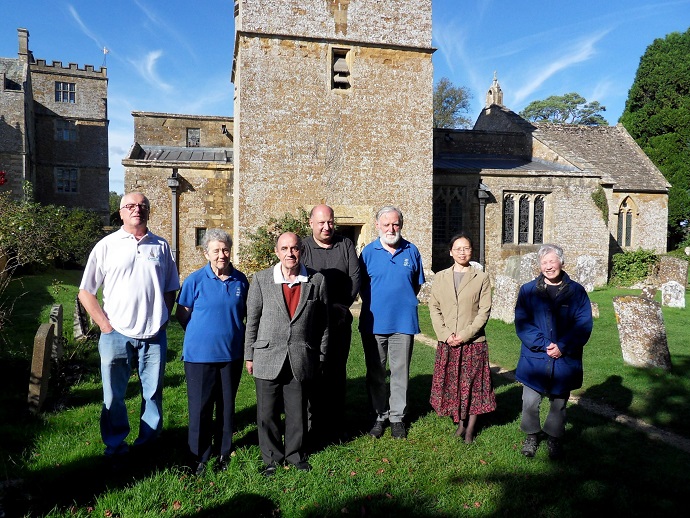
Before SMV
Chastleton Noted as Ceastelton (a farmstead by the prehistoric camp) in 777 A.D., the settlement was later documented as Cestitone in the Domesday Survey. Built around 1607 at the behest of wool merchant Walter Jones, the manor house, built of Cotswold stone, and adjoining church have remained largely unaltered ever since, with the house being noted for its highly ornate panelling, fine glass, and intricate tapestries.
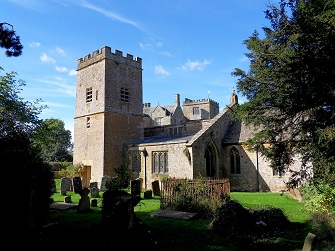
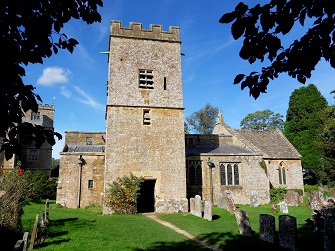 The original manorial house was demolished, having been owned by Robert Catesby, one of the conspirators in the "Gunpowder Plot" of 1605. It is believed he used the proceeds from the sale of the house to help pay for the purchase of the huge quantity of gunpowder that they required. The peaceful gardens of the mansion today include fine topiary work, cut in box and yew, a practice which has been conducted locally since 1700.
The original manorial house was demolished, having been owned by Robert Catesby, one of the conspirators in the "Gunpowder Plot" of 1605. It is believed he used the proceeds from the sale of the house to help pay for the purchase of the huge quantity of gunpowder that they required. The peaceful gardens of the mansion today include fine topiary work, cut in box and yew, a practice which has been conducted locally since 1700.
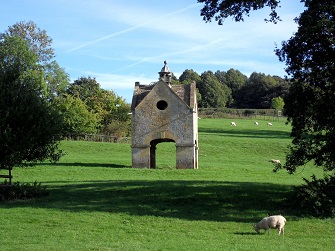 Also to be found here is the first standard size croquet lawn, where a small piece of history was made in 1865, when Chastleton House hosted the meeting which formalised definitive rules for croquet in the wake of the game having become the subject of some levity in Lewis Carroll’s novel Alice in Wonderland just previous to this. Since 1991 the house and its extensive grounds have been owned by the National Trust. The parish church was built late in the 12th century, and enlarged in the 14th century, with the bell-tower added in 1689. There was a restoration, 1878 – 80, to the designs of C.E. Powell. On the north wall are important examples of 17th and 18th century wall paintings which were uncovered in the 1930s. Of the six bells, the third, 1696, is the oldest, cast by Richard Keene of Woodstock. The fourth and fifth are both by Henry III Bagley of Chacombe, 1731. The second is from the same foundry, by Matthew III Bagley, 1762. The treble, 1811, and tenor, 1825, are both by John Rudhall of Gloucester. Henry Bond of Burford refurbished the bells in 1900, and they were re-tuned and re-hung in 1993.
Also to be found here is the first standard size croquet lawn, where a small piece of history was made in 1865, when Chastleton House hosted the meeting which formalised definitive rules for croquet in the wake of the game having become the subject of some levity in Lewis Carroll’s novel Alice in Wonderland just previous to this. Since 1991 the house and its extensive grounds have been owned by the National Trust. The parish church was built late in the 12th century, and enlarged in the 14th century, with the bell-tower added in 1689. There was a restoration, 1878 – 80, to the designs of C.E. Powell. On the north wall are important examples of 17th and 18th century wall paintings which were uncovered in the 1930s. Of the six bells, the third, 1696, is the oldest, cast by Richard Keene of Woodstock. The fourth and fifth are both by Henry III Bagley of Chacombe, 1731. The second is from the same foundry, by Matthew III Bagley, 1762. The treble, 1811, and tenor, 1825, are both by John Rudhall of Gloucester. Henry Bond of Burford refurbished the bells in 1900, and they were re-tuned and re-hung in 1993.

Chastleton

SMV

Chastleton House
Dovecot Folly
Dovecot Folly
Buckinghamshire
Saturday 5th October 2013
09.30am Waddesdon
St Michael (6) 10cwt
10.30am Quainton
St Mary & Holy Cross (8) 17cwt
Erica Ashton, Alan Coates, Marylon Coates, Hugh Deam, Tim Hillsdon, Roy Jones, Judy Kirby, Paul Lucas, Mike Probert, Charlotte Ritchie, Colin Taylor, Darren Washington and Kathy Xu.
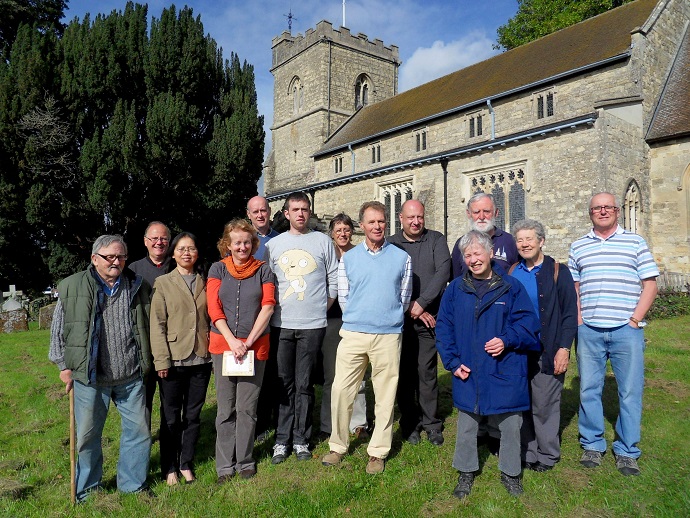
In Quainton churchyard
Waddesdon The village was noted in the Domesday Survey (1086) as Votesdone (Weott's Hill), and developed as an agricultural settlement, with milling, silk weaving and lace-making enterprises. In 1874, Baron Ferdinand de Rothschild effectively created an estate village, with new houses for employees and tenants, a school, a public house and village hall.
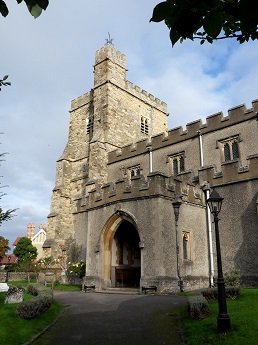 He ordered the building of Waddesdon Manor, which to call it a mansion scarcely does it justice, being constructed (1874 - 1889) in the neo-Renaissance style of a French chateau. The house was designed by Gabriel-Hippolyte Destailleur and the formal gardens, as spectacular as the house, designed by fellow French architect, Elie Laine. The house and grounds are now administered by the National Trust, with the Rothschild family retaining the estate and a house at nearby Eythorpe. Numerous movies and television dramas have utilised Waddesdon as a location (Carry On Don't Lose Your Head, The Queen, Downton Abbey, and Bollywood movies). In 2003, around 100 gold snuffboxes, several of which were made for Marie Antoinette and Madame de Pompadour, were stolen from here and have never been recovered. In 2012 Waddesdon Manor was chosen as one of the sites for Jubilee Woodlands, designated to commemorate the Queen's Diamond Jubilee. The parish church dates from late in the 12th century, with medieval and Victorian additions. The west tower is of two stages with angle buttresses, constructed of coursed rubble and roughcast. The bells are one of very few sets in the country to be made of steel, made in 1861 and 1862, by Naylor, Vickers & Co. of Sheffield.
Quainton The 14th century parish church contains many memorial brasses and sculpture, with the most notable stone effigies in the ground floor ringing room of the
He ordered the building of Waddesdon Manor, which to call it a mansion scarcely does it justice, being constructed (1874 - 1889) in the neo-Renaissance style of a French chateau. The house was designed by Gabriel-Hippolyte Destailleur and the formal gardens, as spectacular as the house, designed by fellow French architect, Elie Laine. The house and grounds are now administered by the National Trust, with the Rothschild family retaining the estate and a house at nearby Eythorpe. Numerous movies and television dramas have utilised Waddesdon as a location (Carry On Don't Lose Your Head, The Queen, Downton Abbey, and Bollywood movies). In 2003, around 100 gold snuffboxes, several of which were made for Marie Antoinette and Madame de Pompadour, were stolen from here and have never been recovered. In 2012 Waddesdon Manor was chosen as one of the sites for Jubilee Woodlands, designated to commemorate the Queen's Diamond Jubilee. The parish church dates from late in the 12th century, with medieval and Victorian additions. The west tower is of two stages with angle buttresses, constructed of coursed rubble and roughcast. The bells are one of very few sets in the country to be made of steel, made in 1861 and 1862, by Naylor, Vickers & Co. of Sheffield.
Quainton The 14th century parish church contains many memorial brasses and sculpture, with the most notable stone effigies in the ground floor ringing room of the
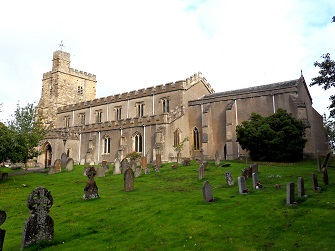
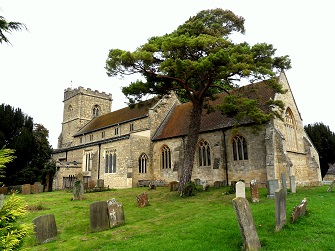 15th century west tower. The bells are a fine set, but demand disciplined handling. This is now a large village with many classic elements still in place at present, a shop, pub, windmill, many fine Georgian houses, a row of 17th century alms-houses near the green, and a church set on high ground. Quainton is an ancient village with a Roman road serving as the parish boundary, and taking its name from Cwen (a queen) and Tun (a farm). In 613A.D. it was in the gift of Edith, a queen
15th century west tower. The bells are a fine set, but demand disciplined handling. This is now a large village with many classic elements still in place at present, a shop, pub, windmill, many fine Georgian houses, a row of 17th century alms-houses near the green, and a church set on high ground. Quainton is an ancient village with a Roman road serving as the parish boundary, and taking its name from Cwen (a queen) and Tun (a farm). In 613A.D. it was in the gift of Edith, a queen
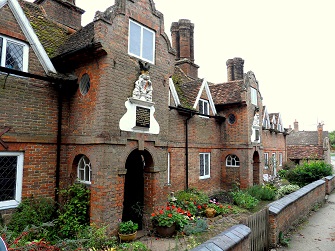 consort of Edward the Confessor. Along the side of the Roman road known as Gypsy Lane, a stone dated to 1641, marks the spot where Edward Boswell "King of the Gypsies" is thought to have been buried, having been executed in Aylesbury. The village has one of the finest examples of a tower-mill in England. Built in 1830 using local bricks, only half a century later, 1881, it had been abandoned and then stood derelict for nearly 100 years until its painstaking restoration began in 1975. After some twenty years of hard work it was finally restored to working order in 1997 and wheat was ground once again. Now owned by a descendant of the original owner it is open to the public, at a small charge, on Sundays. The Winwood Alms-houses, still inhabited, were built in a Gothic style of architecture, belying the construction date of 1687. They are a terrace of eight small cottages, one storey high with a row of dormers in the attics.
consort of Edward the Confessor. Along the side of the Roman road known as Gypsy Lane, a stone dated to 1641, marks the spot where Edward Boswell "King of the Gypsies" is thought to have been buried, having been executed in Aylesbury. The village has one of the finest examples of a tower-mill in England. Built in 1830 using local bricks, only half a century later, 1881, it had been abandoned and then stood derelict for nearly 100 years until its painstaking restoration began in 1975. After some twenty years of hard work it was finally restored to working order in 1997 and wheat was ground once again. Now owned by a descendant of the original owner it is open to the public, at a small charge, on Sundays. The Winwood Alms-houses, still inhabited, were built in a Gothic style of architecture, belying the construction date of 1687. They are a terrace of eight small cottages, one storey high with a row of dormers in the attics.
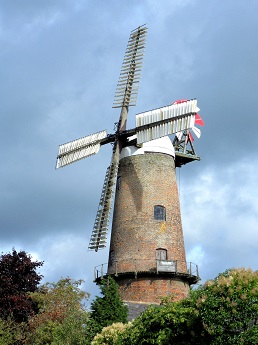 The terrace is decorated by two porches, with a plaque above, and further adorned by diagonally placed chimney stacks. The Buckinghamshire Railway Centre is operated from Quainton Road railway station, the site being divided into two halves connected by tow foot-bridges. Each side has a demonstration line with workshop and museum buildings. Although the BRC's trains are run on the former station sidings, the station still has a working Network Rail line passing through it. The number of locomotives, carriages and assorted rolling stock housed here is now approaching the 200 mark. The parish church is a 14th century building in the Decorated Gothic style, and contains many memorial brasses and sculpture, including the tomb of Thomas Stayner (1689). Stone effigies depict the deceased lying in full armour, whilst his widow rests beside him. In the chancel are a reredos and sedilia by William White who was also responsible for the rebuilding of the chancel in 1877. The 15th century west tower contains eight bells which are rung from the ground floor. The oldest bells are the fifth & sixth, 1621, cast by Henry I Knight of Reading. The tenor, 1745, is by Thomas Lester, Whitechapel Foundry. The other bells are by Taylors of Loughborough: fourth (1957); third & seventh (1983); and the front two bells (1985).
The terrace is decorated by two porches, with a plaque above, and further adorned by diagonally placed chimney stacks. The Buckinghamshire Railway Centre is operated from Quainton Road railway station, the site being divided into two halves connected by tow foot-bridges. Each side has a demonstration line with workshop and museum buildings. Although the BRC's trains are run on the former station sidings, the station still has a working Network Rail line passing through it. The number of locomotives, carriages and assorted rolling stock housed here is now approaching the 200 mark. The parish church is a 14th century building in the Decorated Gothic style, and contains many memorial brasses and sculpture, including the tomb of Thomas Stayner (1689). Stone effigies depict the deceased lying in full armour, whilst his widow rests beside him. In the chancel are a reredos and sedilia by William White who was also responsible for the rebuilding of the chancel in 1877. The 15th century west tower contains eight bells which are rung from the ground floor. The oldest bells are the fifth & sixth, 1621, cast by Henry I Knight of Reading. The tenor, 1745, is by Thomas Lester, Whitechapel Foundry. The other bells are by Taylors of Loughborough: fourth (1957); third & seventh (1983); and the front two bells (1985).

Waddesdon

Waddesdon · St Michael

Quainton · St Mary

17th century alms houses

Quainton windmill
Oxfordshire
Saturday 5th October 2013
2.30pm Weston on the Green
St Mary (6) 8cwt
Alan Coates, Marylon Coates, Hugh Deam, Judy Kirby, Paul Lucas and Darren Washington.
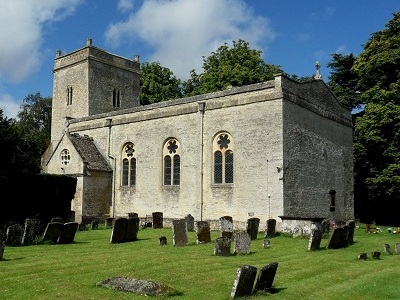
Weston on the Green · St Mary
Weston on the Green At the time of the Norman Conquest of 1066, Wigod of Wallingford held the Manor of Weston, and on his death the estates passed to his Norman in-laws, the D' Oyly family, who granted lands here to Osney Abbey. During the 15th century Weston Manor House was built within an existing 13th century moat for the bailiff of the abbey. The moat was filled in during 1908, with the house now being a hotel. RAF Weston on the Green was built during World War I for the Royal Flying Corps, and now serves as a parachute training station. One of the pubs in the village is known as the Ben Jonson, is named after the Elizabethan playwright who stayed in Weston on several occasions during his journeys from London to visit his friend William Shakespeare in Stratford. Also in the village is a popular ice-cream parlour and café that always has over 20 flavours of ice-cream on offer, made from locally produced milk on the farm here which has diversified successfully. The parish church retains Saxon work in the lower part of the tower, with the main body of the church rebuilt during the 18th century after having fallen into a ruinous state, the funds provided by the Norreys Bertie family. The church was restored in 1885 by R. Phene Spiers, repairing the tower and adding the south porch. Three bells were cast in consecutive centuries for the tower from the 15th century onwards, but these were replaced by five bells cast by Mears & Stainbank of Whitechapel in 1870. The treble was added in 2013 by Taylor's of Loughborough thanks to a donation from a parishioner, the bells having been declared unringable for some years prior to this.
Oxfordshire
Saturday 28th September 2013
2.30pm Stanton Harcourt
St Michael (6) 11cwt in F · Oxon OX29 5RJ
4.00pm Hinton Waldrist
St Margaret (6) 6-2-19 in Bb · Oxon SN7 8SA
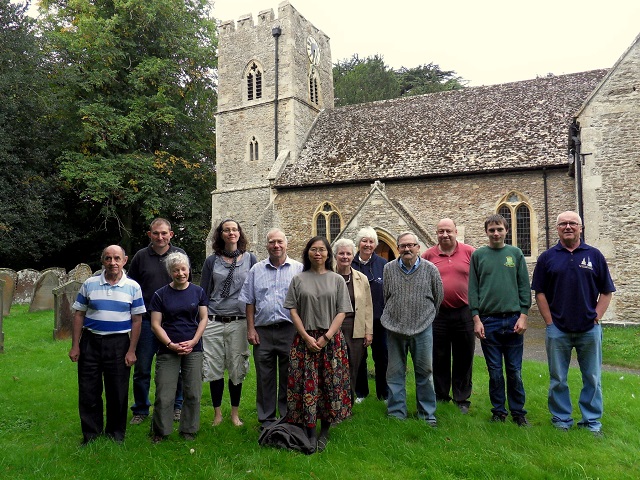
Hinton Waldrist · St Margaret
Jane Burgess, Ron Burgess, Hugh Deam, Roy Jones, Judy Kirby, Paul Lucas, Bernard Masterman, Donna Murphy, Isaac O'Shea, Kathy Xu, Nigel Eagle and Diane Clark.
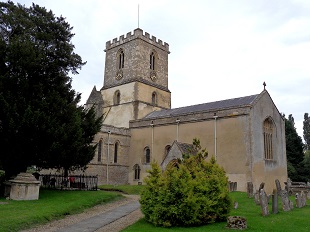
Stanton Harcourt · St Michael
Stanton Harcourt The early settlement here was known merely as Stantone (farmstead on stony ground), with the affix stemming from the de Harecurt family, here from the 12th century; around 1275 the village was documented as Stantone Harecurte. Within the parish is a series of paleochannel deposits buried beneath the second gravel terrace of the River Thames. These deposits, which have been attributed to marine isotope stages, were the subject of archaeological and paleontological research. Evidence was found for the co-existence of species of elephant and mammoth during interglacial conditions, disproving widely held view that mammoths were an exclusively cold-adapted species. During World War II there was an airfield close to the village which acted as a transit point for Winston Churchill and the starting point for a bomber raid on the German battle-cruiser, Scharnhorst.
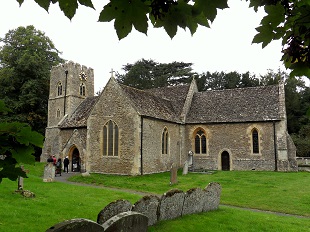 The parish church dates from 1135, with the Norman nave and lower part of the tower being the oldest remaining features. During the 13th century, the chancel, chancel arch and tower arches were rebuilt, and the transepts and stair turret were added. In the 15th century the upper part of the tower was completed. The Harcourt Chapel was added on the south side of the chancel. The bells are rung from a gargantuan ringing chamber, and hung in a 17th century oak frame. The middle four bells are the oldest, cast in 1656 by itinerant founder, Michael Darbie. The tenor is from 1686, by Richard Keene of Woodstock. The treble was added in 1722 by Abraham II Rudhall of Gloucester.
Hinton Waldrist Documented as Hentone (high or chief farmstead) in the Domesday Survey, the village did not gain its affix until 1676,
The parish church dates from 1135, with the Norman nave and lower part of the tower being the oldest remaining features. During the 13th century, the chancel, chancel arch and tower arches were rebuilt, and the transepts and stair turret were added. In the 15th century the upper part of the tower was completed. The Harcourt Chapel was added on the south side of the chancel. The bells are rung from a gargantuan ringing chamber, and hung in a 17th century oak frame. The middle four bells are the oldest, cast in 1656 by itinerant founder, Michael Darbie. The tenor is from 1686, by Richard Keene of Woodstock. The treble was added in 1722 by Abraham II Rudhall of Gloucester.
Hinton Waldrist Documented as Hentone (high or chief farmstead) in the Domesday Survey, the village did not gain its affix until 1676,
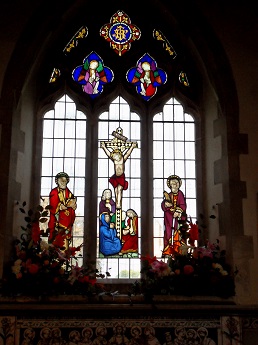 this manorial affix denoting the De Sancto Walerico family, here from the 12th century. The Manor of Hinton was long held by the St Valery family whose ancient castle stood near the site of the present manor house, guarding the river crossing. Hinton Waldrist Castle was originally a motte and bailey, with a moat. During the Middle Ages it was rebuilt in stone and was where Mary de Bohun was brought up and married Henry Bolingbroke, who later became Henry IV. Their son, later crowned Henry V, often visited the castle in his younger days. Only earthworks are now visible of the castle, just to the south-west of the present manor house. Hinton Waldrist is the subject of 59 stereoscopic images produced by Victorian photographer T.R. Williams in 1856. This series of photographs is the subject of a book entitled "A Village Lost and Found", co-authored by Queen guitarist Brian May. A copy of this book is on display in the church. A place of worship was established here by the Saxons, but the present building is essentially a late 13th century replacement that was constructed adjacent to what was once a moated area. There has been extensive remodelling since the 13th century, with the church being Grade II Listed. The bells are an exceptionally fluent six which are rung from the ground floor. The oldest bells are the second, third and fourth, 1709, by Abraham I Rudhall of Gloucester. The fifth is by William Taylor at the Oxford foundry, 1843. The tenor is from 1868, cast at Whitechapel, and the treble was added in 1928 by Taylor's of Loughborough.
this manorial affix denoting the De Sancto Walerico family, here from the 12th century. The Manor of Hinton was long held by the St Valery family whose ancient castle stood near the site of the present manor house, guarding the river crossing. Hinton Waldrist Castle was originally a motte and bailey, with a moat. During the Middle Ages it was rebuilt in stone and was where Mary de Bohun was brought up and married Henry Bolingbroke, who later became Henry IV. Their son, later crowned Henry V, often visited the castle in his younger days. Only earthworks are now visible of the castle, just to the south-west of the present manor house. Hinton Waldrist is the subject of 59 stereoscopic images produced by Victorian photographer T.R. Williams in 1856. This series of photographs is the subject of a book entitled "A Village Lost and Found", co-authored by Queen guitarist Brian May. A copy of this book is on display in the church. A place of worship was established here by the Saxons, but the present building is essentially a late 13th century replacement that was constructed adjacent to what was once a moated area. There has been extensive remodelling since the 13th century, with the church being Grade II Listed. The bells are an exceptionally fluent six which are rung from the ground floor. The oldest bells are the second, third and fourth, 1709, by Abraham I Rudhall of Gloucester. The fifth is by William Taylor at the Oxford foundry, 1843. The tenor is from 1868, cast at Whitechapel, and the treble was added in 1928 by Taylor's of Loughborough.

Hinton Waldrist · St Margaret

Within St Margaret
Hampshire
Saturday 29th June 2013
Holybourne
Holy Rood (8) 6-3-16 in B · Hants GU34 4HH
Alton
All Saints (6) 6-0-4 in B · Hants GU34 1HU
Chawton
St Nicholas (6) 6-0-26 in B · Hants GU34 1SJ
Herriard
St Mary (6) 7-2-11 in A · Hants RG25 2PH
Alan Coates, Simon King, Bernard Masterman, Hugh Deam, Susan King, Alison Merryweather-Clarke, Toby Goss, Judy Kirby, Mike Probert, Roy Jones, Paul Lucas, Charles Smith.
Plain & Little Bob Major, Stedman Triples, Grandsire Triples, Cambridge, Double Oxford, Single Oxford, Double Bob, St Clements, St Nicholas, St Simon's, St Martin's, All Saints, Antelope.
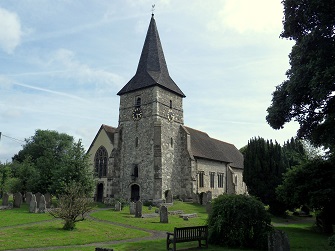
Holy Rood · Holybourne
Holybourne The name of the village derives from the Anglo-Saxon description of a "holy stream", being documented as Haliburne in 1086. Britain's most famous gardener, Alan Titchmarsh, a regular on television since the 1980's lives in the village and paid for a new set of bells to be installed. The church, sited adjacent to a lake with a central island inhabited by swans, has foundations dating to the 12th century, with the nave, west end and lower part of the tower all seemingly from this period. A new set of eight bells were cast at Whitechapel and installed by White's in 2009 with each of them inscribed and dedicated to a notable figure associated with this area. In order from treble to tenor - Jane Austen, Elizabeth Gaskell, William Curtis (botanist), Alfred Munnings (painter), Edmund Spenser (poet), Edward Thomas (poet), Izaak Walton (angler & biographer), Rev. Gilbert White (curate & naturalist). The three original bells were cleaned and re-hung on a new bell-frame installed higher up in the steeple and connected back to the clock so as to continue their chiming role.
Alton The town stands on the site of a Roman settlement that was known as Vindomis and which was on the route between Chichester and Silchester.
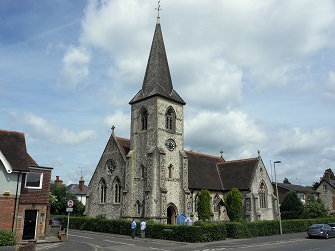
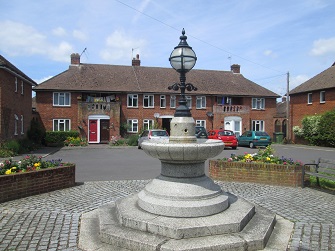 The present name denotes a farmstead at the source of a river, the River Wey having its source here. The Treaty of Alton was signed in the town in 1101, this being an agreement signed between William the Conqueror's eldest son Robert, Duke of Normandy and his brother Henry I of England who had seized the throne whilst his older brother was away on the first crusade; The main road through the town is consequently known as Normandy Street. With hops and barley being grown in the surrounding countryside breweries have operated in the town since 1763, with the earliest maltings still standing, although no longer in use.
The present name denotes a farmstead at the source of a river, the River Wey having its source here. The Treaty of Alton was signed in the town in 1101, this being an agreement signed between William the Conqueror's eldest son Robert, Duke of Normandy and his brother Henry I of England who had seized the throne whilst his older brother was away on the first crusade; The main road through the town is consequently known as Normandy Street. With hops and barley being grown in the surrounding countryside breweries have operated in the town since 1763, with the earliest maltings still standing, although no longer in use.
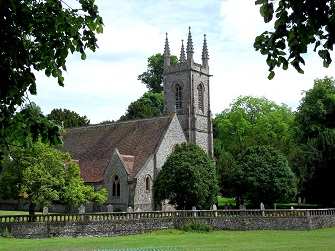 There is still a brewery here producing Grolsch and Carling lager. The French Horn pub is housed in a building that dates to 1640, although it only became used as a pub later. As it was such a nice day we were able to enjoy our lunch in the garden and catch regular glimpses of trains running on the heritage railway, the Watercress Line. All Saints church is the smaller of the two Anglican churches with bells in the town, and like Holybourne have recently cast bells. On the short walk between the pub and the church we encountered Miss Bell's Fountain, a combined drinking fountain and street lamp that was a Victorian era munificent gift to the town.
Chawton There has been a church here since the 13th century, with much of its histor linked with Chawton House, ordered built in 1578 by John Knight, Lord of the Manor. The Knight family adopted Edward, third brother of Jane Austen, so beginning the connection between Jane Austen and the village.
There is still a brewery here producing Grolsch and Carling lager. The French Horn pub is housed in a building that dates to 1640, although it only became used as a pub later. As it was such a nice day we were able to enjoy our lunch in the garden and catch regular glimpses of trains running on the heritage railway, the Watercress Line. All Saints church is the smaller of the two Anglican churches with bells in the town, and like Holybourne have recently cast bells. On the short walk between the pub and the church we encountered Miss Bell's Fountain, a combined drinking fountain and street lamp that was a Victorian era munificent gift to the town.
Chawton There has been a church here since the 13th century, with much of its histor linked with Chawton House, ordered built in 1578 by John Knight, Lord of the Manor. The Knight family adopted Edward, third brother of Jane Austen, so beginning the connection between Jane Austen and the village.
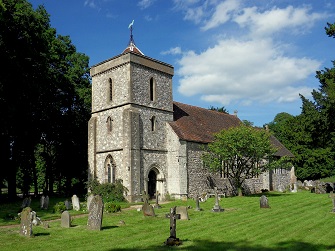 Jane Austen's House is akin to a place of pilgrimage for tourists from around the world. The Austen family regularly worshipped in the church here, and Jane's mother and sister are buried in the churchyard. A fire in 1871 destroyed much of the original church building, although the chancel remained untouched, so the present church is primarily Victorian. As with the first two churches the bells here are recently cast in 2009.
Herriard Documented as Herierda in 1160 the settlement may have taken its name from the billeting quarters of a Viking army or derive from the Celtic description for a long ridge. As with Chawton the church is situated on a manorial estate. St Mary's church was ordered built by Lord of the Manor, Sir Richard de Herriard around 1200, although much of the interior work on view today dates from the major refurbishment of 1878 ordered by Francis Jervoise of Herriard House. The stone-built west tower was added at this time as a replacement for the original wooden turret that had partly collapsed. The ringing chamber is accessed via a selection of ladders akin to a scene out of the Poseidon Adventure, although not upside down of course. Unlike the other towers most of the bells here are of some considerable age, the fifth dating back to 1399.
Jane Austen's House is akin to a place of pilgrimage for tourists from around the world. The Austen family regularly worshipped in the church here, and Jane's mother and sister are buried in the churchyard. A fire in 1871 destroyed much of the original church building, although the chancel remained untouched, so the present church is primarily Victorian. As with the first two churches the bells here are recently cast in 2009.
Herriard Documented as Herierda in 1160 the settlement may have taken its name from the billeting quarters of a Viking army or derive from the Celtic description for a long ridge. As with Chawton the church is situated on a manorial estate. St Mary's church was ordered built by Lord of the Manor, Sir Richard de Herriard around 1200, although much of the interior work on view today dates from the major refurbishment of 1878 ordered by Francis Jervoise of Herriard House. The stone-built west tower was added at this time as a replacement for the original wooden turret that had partly collapsed. The ringing chamber is accessed via a selection of ladders akin to a scene out of the Poseidon Adventure, although not upside down of course. Unlike the other towers most of the bells here are of some considerable age, the fifth dating back to 1399.

All Saints · Alton

Miss Bell's Fountain

St Nicholas · Chawton

St Mary · Herriard
North Leigh
Saturday 8th June 2013
10:30 North Leigh
St Mary (6) 9-3-15 in G · Oxon OX29 6TX
Jon Chamberlain, Roy Jones, Bernard Masterman, Colin Taylor, Hugh Deam, Judy Kirby, Julie Minch, Wendy Tynan, Neil Ephgrave, Paul Lucas, Graham Peck, Kathy Xu, Toby Goss, Matthew Malek and Mike Probert.
Cambridge, Double Oxford, Single Oxford, St Clements, PB Minor, Stedman & Grandsire.
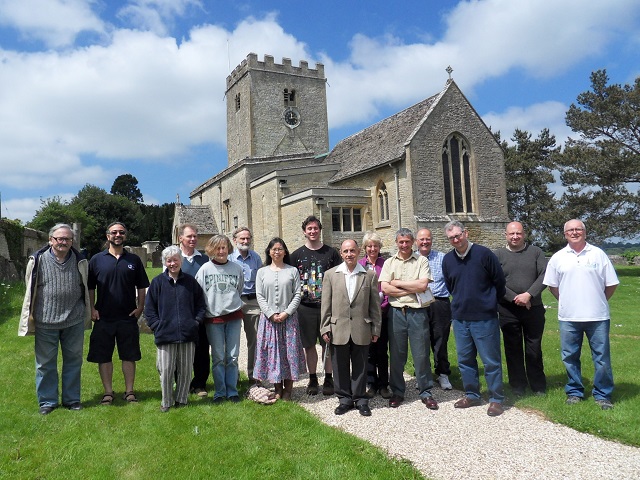
North Leigh · St Mary
North Leigh Documented as Northleg (northern end of a wood) in 1225, the village is situated on a ridge between the two valleys created by the Evenlode and Windrush rivers. This ridge was used as the route of Akeman Street during the Roman occupation, which has left firm evidence of its presence here, with the remains of a large villa open to view just outside the village at "East End". This was once a country residence of some splendour with its own heating system and mosaic floor.
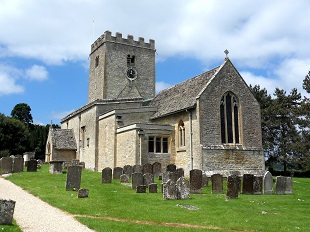 Several Oxford colleges used the quality building stone quarried here, especially Oriel College. The common to the south of the village is a 41acre heath, incorporating disused clay pits and rare plants such as the marsh orchid. The village itself is a riot of colour during the summer months, with countless roses and hollyhocks in bloom. The handsome parish church retains facets from 1000AD to 1200. The Wilcote Chapel, is replete with the most intricate of decoration, superb fan-traceried roof, Perpendicular windows, and high quality stained-glass. The broad Saxon tower is one of the oldest surviving towers in the county. All six bells were cast in 1875 at the Whitechapel Bell Foundry, with the sallies sporting one of the lesser seen designs, being violet in colour. One of the many peal-boards in the ringing chamber details a peal from 1879 which underlines the Oxford University connection here as all the participants was assigned to a college, Keble (3), Oriel, Pembroke and Wadham. If you have never rung on the bells here then I suspect that everyone who was with us would entreat you to do so whenever the opportunity arises.
Several Oxford colleges used the quality building stone quarried here, especially Oriel College. The common to the south of the village is a 41acre heath, incorporating disused clay pits and rare plants such as the marsh orchid. The village itself is a riot of colour during the summer months, with countless roses and hollyhocks in bloom. The handsome parish church retains facets from 1000AD to 1200. The Wilcote Chapel, is replete with the most intricate of decoration, superb fan-traceried roof, Perpendicular windows, and high quality stained-glass. The broad Saxon tower is one of the oldest surviving towers in the county. All six bells were cast in 1875 at the Whitechapel Bell Foundry, with the sallies sporting one of the lesser seen designs, being violet in colour. One of the many peal-boards in the ringing chamber details a peal from 1879 which underlines the Oxford University connection here as all the participants was assigned to a college, Keble (3), Oriel, Pembroke and Wadham. If you have never rung on the bells here then I suspect that everyone who was with us would entreat you to do so whenever the opportunity arises.

St Mary
Yarnton & Bletchingdon
Saturday 1st June 2013
16:15 Yarnton
St Bartholomew (6) 22-1-19 in D · Oxon OX5 1PY
17:45 Bletchingdon
St Giles (6) 8-0-1 in A · Oxon OX5 3DL
Cambridge, St Clements, Plain Bob Minor and Stedman.
Erica Ashton, Toby Goss, Charlotte Ritchie, Sue Macready, Hugh Deam, Roy Jones, Charles Smith, Rose Swift, Andrew Dunn, Judy Kirby, Sarah Wheeler, Neil Ephgrave, Paul Lucas, Kathy Xu, Sue Fenn, Bernard Masterman & Jane Carlo.
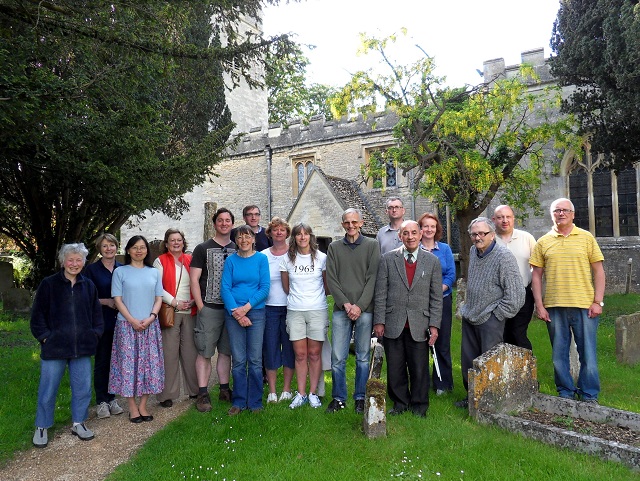
Yarnton · St Bartholomew
Yarnton A settlement here was first noted in 1005 as Aerdintune (Earda's estate) at a time when most of the land was owned by Eynsham Abbey, but early Bronze Age decorated beakers have been unearthed in the parish, suggesting human activity in the area between 2700 to 1700 BC. Sir Thomas Spencer had the distinctive Jacobean mansion of Yarnton Manor built in 1611. During the Civil War the house served as a Royalist military hospital. The manor house is now the headquarters for the Oxford Centre for Jewish and Hebrew Studies. The 13th century parish church, a rebuilding of the 1161 Norman chapel for Eynsham Abbey, stands adjacent to the entrance to the manor house. The Perpendicular Gothic Spencer Chapel was added at the same time as Yarnton Manor was being built, 1611. The chapel's windows contain heraldic stained glass representing branches of the Spencer family and are the largest collection of such heraldic glass of that century in the Oxfordshire. The 17th century tower houses a set of bells that are just outside the top ten heaviest peals of six in the country. Five of the bells date to 1620, with the other being a recasting from 1853 at Oxford Foundry of the original 1618 bell.
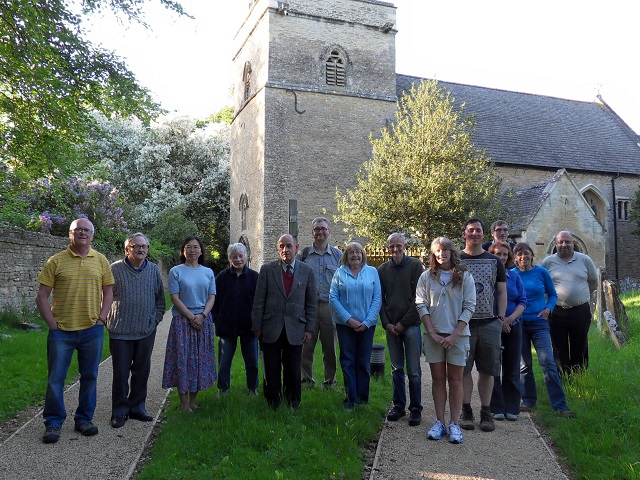 Bletchingdon The village was originally built around a green, but the houses on the north side were pulled down when Bletchingdon Park was extended. The endearingly appointed parish church stands at alongside the grounds of Bletchingdon Park, to the east of the village. The present Palladian mansion, the third to stand on the site, commands extensive views of generously wooded parkland. The original medieval manor house was rebuilt around 1630 for Sir Thomas Coghill and was fortified and garrisoned by Royalist troops during the perfervid years of the English Civil War. Colonel Francis Windebank was appointed governor of Bletchingdon House during this time, but in the wake of the Royalist defeat at Islip the house came under attack from overwhelming Parliamentary forces in April 1645 and Windebank surrendered the house at the first summons to avoid further bloodshed. He was subsequently tried by a Royalist court-martial and shot. The church contains traces of Norman architecture, with the chancel dating to the Early English period of the 13th century. The north aisle was added in 1869 as part of the heavy restoration conducted to the designs of Charles Buckeridge. The bells are rung from the ground floor, but are extremely benevolent having been rehung to great effect at the Millennium.
Bletchingdon The village was originally built around a green, but the houses on the north side were pulled down when Bletchingdon Park was extended. The endearingly appointed parish church stands at alongside the grounds of Bletchingdon Park, to the east of the village. The present Palladian mansion, the third to stand on the site, commands extensive views of generously wooded parkland. The original medieval manor house was rebuilt around 1630 for Sir Thomas Coghill and was fortified and garrisoned by Royalist troops during the perfervid years of the English Civil War. Colonel Francis Windebank was appointed governor of Bletchingdon House during this time, but in the wake of the Royalist defeat at Islip the house came under attack from overwhelming Parliamentary forces in April 1645 and Windebank surrendered the house at the first summons to avoid further bloodshed. He was subsequently tried by a Royalist court-martial and shot. The church contains traces of Norman architecture, with the chancel dating to the Early English period of the 13th century. The north aisle was added in 1869 as part of the heavy restoration conducted to the designs of Charles Buckeridge. The bells are rung from the ground floor, but are extremely benevolent having been rehung to great effect at the Millennium.

Bletchingdon · St Giles
Lower Heyford & Somerton
Saturday 18th May 2013
15:45 Lower Heyford
St Mary (6) 6-3-20 in Bb · Oxon OX25 5NR
17:15 Somerton
St James (8) 11-3-23 in F · Oxon OX25 6NB
Hugh Deam, Susan King, Paul Lucas, Alison Merryweather, Roy Jones, Judy Kirby, Bernard Masterman & Neil Clare.
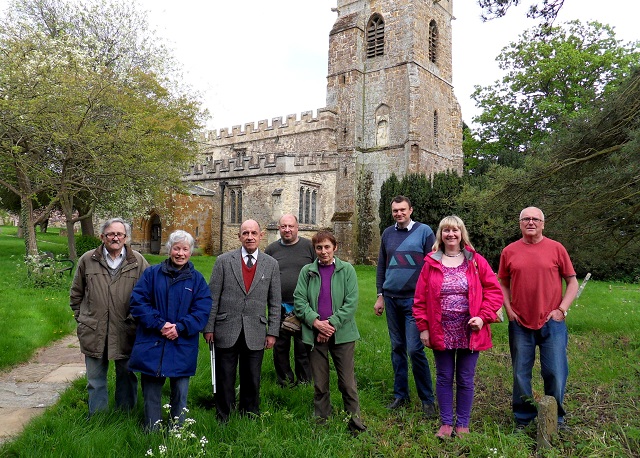
Somerton · St James
Lower Heyford Described as Hegford in the Domesday Book, the name denotes the ford used chiefly at hay-making time. The area has regained its tranquil demeanour in recent years since the closure of the USAF Base at the twin village of Upper Heyford. For many years the airspace here was characterised by the sound of military aircraft flying to and fro. Lower Heyford boasts a village square with a tree and benches at its heart, surrounded by a plenitude of elegant stone-built cottages and the 17th century public house. There has been a bridge over the River Cherwell between the village and Steeple Aston since at least 1255. The earliest parts of the present bridge are 14th century. The parish church is located at the far end of a narrow track that branches off from the village square, and was consecrated in 1065 by the Saxon Bishop Wulfin of Dorchester, although the present church is a rebuilding of 1350, with substantial 15th century alteration and addition. The Perpendicular Gothic clerestory and south porch were added at this time. During the time of Edward VI the tower had a ring of four bells. The six bells here today were cast at various foundries (Chacombe, Oxford, Whitechapel)
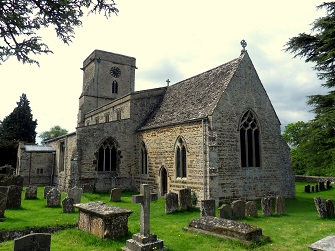
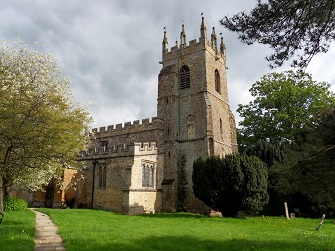 since 1766. Somerton The name of the village describes a farmstead used in summer, the settlement here at the time of the Domesday Survey being noted as Sumertone. The village is set close to the Oxford Canal and enjoys extensive views across the surrounding valleys. Somerton Turf Maze is one of only 8 turf labyrinths or mazes surviving in England, and one of the best preserved. Formed by cutting the ground surface to leave turf ridges and shallow trenches, it measures 50ft x 60ft and consists of 15 concentric circles, with the path being 1ft wide. The design has been compared to a pattern of 12th century floor tiles in Toussants Abbey in France. The parish church is Grade I Listed and is lavishly endowed inside and out, primarily due to the Fermor family, Lords of the Manor in the 16th century. Effigies and hatchments of the family dominate the Fermor Chapel. The magnificent Whall Window at the east end of the north aisle is an early work of Christopher Whitworth Whall, a leading designer of stained-glass in the Arts & Crafts Movement. The tower contains eight superbly resonant bells which are rung from the ground floor. Up until the end of the 19th century there were five bells here, dating mostly to early in the 17th century. A sixth bell was added in 1896 and in 1931 the six bells were re-hung into a steel frame, but with provision made so two more bells could be added in the future, something which eventually happened in 1993.
since 1766. Somerton The name of the village describes a farmstead used in summer, the settlement here at the time of the Domesday Survey being noted as Sumertone. The village is set close to the Oxford Canal and enjoys extensive views across the surrounding valleys. Somerton Turf Maze is one of only 8 turf labyrinths or mazes surviving in England, and one of the best preserved. Formed by cutting the ground surface to leave turf ridges and shallow trenches, it measures 50ft x 60ft and consists of 15 concentric circles, with the path being 1ft wide. The design has been compared to a pattern of 12th century floor tiles in Toussants Abbey in France. The parish church is Grade I Listed and is lavishly endowed inside and out, primarily due to the Fermor family, Lords of the Manor in the 16th century. Effigies and hatchments of the family dominate the Fermor Chapel. The magnificent Whall Window at the east end of the north aisle is an early work of Christopher Whitworth Whall, a leading designer of stained-glass in the Arts & Crafts Movement. The tower contains eight superbly resonant bells which are rung from the ground floor. Up until the end of the 19th century there were five bells here, dating mostly to early in the 17th century. A sixth bell was added in 1896 and in 1931 the six bells were re-hung into a steel frame, but with provision made so two more bells could be added in the future, something which eventually happened in 1993.

Lower Heyford · St Mary

Somerton · St James
Wiltshire
Saturday 27th April 2013
15:00 Lacock
St Cyriac (6) 12-2-14 in F · Wilts SN15 2LB
16:30 Langley Burrell
St Peter (6) 10cwt in G · Wilts SN15 5LY
Hugh Deam, Anthony Hughes, Bernard Masterman, Ailsa Reid, Andrew Dunn, Roy Jones, Alison Merryweather-Clarke, Charles Smith, Neil Ephgrave, Judy Kirby, David Parks, Adrian Gray, Paul Lucas and Mike Probert.
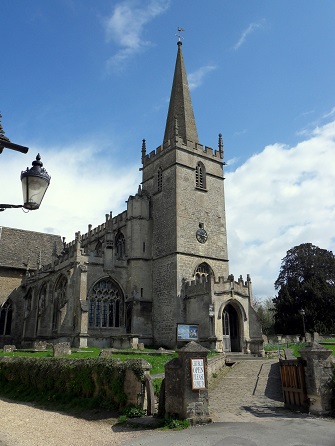
Lacock · St Cyriac
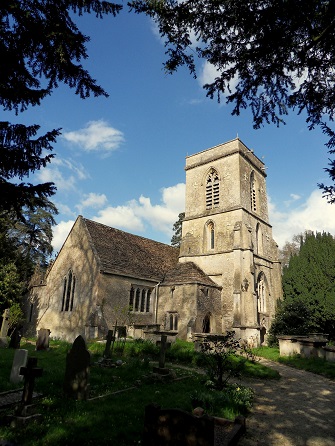
Langley Burrell · St Peter
Lacock Known as Lacok in 854 AD, the name describes a small stream. In the care of the National Trust since 1944, this is one of England's most beautiful and diligently preserved villages, with the River Avon and lush water-meadows forming part of the parish boundary. Lacock is awash with thatched and stone cottages, and its Tudor feel has made it immensely popular as a film and television location (Cranford, Poirot, Pride & Prejudice, Emma,
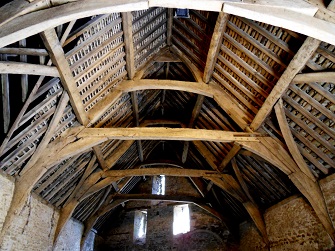 The Other Boleyn Girl, Moll Flanders and Harry Potter). The market-hall in Earl Street is actually a subtle conversion from a 14th century tithe barn. One of the early pioneers of the photographic process, William Henry Fox-Talbot lived in Lacock, and there is a museum here that bears his name. He was also a mathematician, physicist, philologist and responsible for remodelling the south side of the abbey. Lacock Abbey was founded as a nunnery in 1229 by Ela, Countess of Salisbury. The village is indisputably on the tourist trail with the bakery, gift shops and ancillary attractions all in keeping with the period facade. The elegant (Grade 1 Listed) 15th century church is styled in the classic Perpendicular manner, and on a cruciform plan, with remains of the previous building still visible in the lower part of the tower. The dedication to St Cyriac commemorates a favourite Norman saint, Cyriacus, a Christian martyr who was killed in the Persecution of Diocletian. In 2012 the church was given permission to sell its silver medieval chalice (the Lacock Cup) to the British Museum for £1.3m. In 1604 the recessed octagonal tower was rebuilt, with the ringing chamber being accessed via either a door on the outside or a door on the inside that connects to the same staircase of just ten steps.
The Other Boleyn Girl, Moll Flanders and Harry Potter). The market-hall in Earl Street is actually a subtle conversion from a 14th century tithe barn. One of the early pioneers of the photographic process, William Henry Fox-Talbot lived in Lacock, and there is a museum here that bears his name. He was also a mathematician, physicist, philologist and responsible for remodelling the south side of the abbey. Lacock Abbey was founded as a nunnery in 1229 by Ela, Countess of Salisbury. The village is indisputably on the tourist trail with the bakery, gift shops and ancillary attractions all in keeping with the period facade. The elegant (Grade 1 Listed) 15th century church is styled in the classic Perpendicular manner, and on a cruciform plan, with remains of the previous building still visible in the lower part of the tower. The dedication to St Cyriac commemorates a favourite Norman saint, Cyriacus, a Christian martyr who was killed in the Persecution of Diocletian. In 2012 the church was given permission to sell its silver medieval chalice (the Lacock Cup) to the British Museum for £1.3m. In 1604 the recessed octagonal tower was rebuilt, with the ringing chamber being accessed via either a door on the outside or a door on the inside that connects to the same staircase of just ten steps.
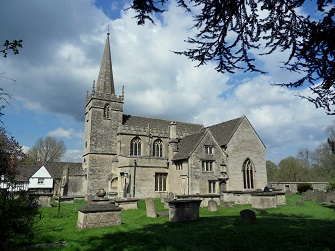
 The bells here are a simply magnificent peal which should be on any ringers list to visit.
Langley Burrell Documented as Langelegh (a long wood) in 940 AD, the manorial affix relates to the Burrel family, here from the 13th century. This small village set above the River Avon is well known to avid walkers due to being the termini of the eponymous Maud Heath's Causeway that runs from Chippenham to Wick Hill, this routeway having been used by her to travel to Chippenham Market to sell eggs in the
The bells here are a simply magnificent peal which should be on any ringers list to visit.
Langley Burrell Documented as Langelegh (a long wood) in 940 AD, the manorial affix relates to the Burrel family, here from the 13th century. This small village set above the River Avon is well known to avid walkers due to being the termini of the eponymous Maud Heath's Causeway that runs from Chippenham to Wick Hill, this routeway having been used by her to travel to Chippenham Market to sell eggs in the
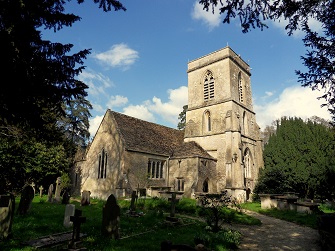 15th century. By the time of her death in 1474 she had become one of the richest local inhabitants and left a bequest of £8 per year to maintain the causeway. A charity fund in her name continues to provide yearly funds for the upkeep of the route. A sundial on the route marks the spot where she is said to have set off each morning. The public house here - The Langley Tap - is locally known merely as "The Tap" due to its having once been adjacent to a brewery and the beer being literally "on tap". There has been a church in the village since the 9th century, with the lower portion of the south wall of the nave and porch being Saxon work. The nave was rebuilt late in the 12th century and an aisle was added, with the chancel being constructed in the following century. In the porch are the remains of a holy water stoup and there are traces of medieval wall paintings below the corbels in the nave. Not surprisingly, the church is a Grade 1 Listed Building. The famous Victorian diarist Francis Kilvert acted as Curate to his father Richard who was a Rector of St Peter's. The 14th century tower for over three centuries contained just the four bells from the 17th century, with two new bells being installed in 2000. The excellent bells here were well worth visiting.
15th century. By the time of her death in 1474 she had become one of the richest local inhabitants and left a bequest of £8 per year to maintain the causeway. A charity fund in her name continues to provide yearly funds for the upkeep of the route. A sundial on the route marks the spot where she is said to have set off each morning. The public house here - The Langley Tap - is locally known merely as "The Tap" due to its having once been adjacent to a brewery and the beer being literally "on tap". There has been a church in the village since the 9th century, with the lower portion of the south wall of the nave and porch being Saxon work. The nave was rebuilt late in the 12th century and an aisle was added, with the chancel being constructed in the following century. In the porch are the remains of a holy water stoup and there are traces of medieval wall paintings below the corbels in the nave. Not surprisingly, the church is a Grade 1 Listed Building. The famous Victorian diarist Francis Kilvert acted as Curate to his father Richard who was a Rector of St Peter's. The 14th century tower for over three centuries contained just the four bells from the 17th century, with two new bells being installed in 2000. The excellent bells here were well worth visiting.

The market-hall in Earl Street

Lacock

The ringing chamber

Langley Burrell
City Branch outing to Cambridgeshire
Saturday 23rd March 2013
10:15 Over
St Mary (8) 13-2-9 in F# · Cambs CB24 5NH
11:30 Willingham
St Mary & All Saints (6) 11-3-10 in G · Cambs CB24 5HT
12:30 The White Horse
28 Longstanton Rd · Oakington · Cambs CB24 3AB
14:15 Oakington
St Andrew (6) 5-2-20 in A · Cambs CB24 3AN
15:15 Longstanton
All Saints (8) 7-2-11 in A · Cambs CB24 3BL
Erica Ashton, Judy Kirby, Charles Smith, Christian Burrell, Paul Lucas, Hannah Cartwright, Hugh Deam, Matthew Malek, Jasmine Cartwright, Toby Goss, Donna Murphy, Mike Cartwright, Roy Jones, Graham Nichols, Simon King, Mike Probert, Susan King and John Pusey.
Over Situated on the River Great Ouse the village is an edge of fen settlement. It is widely believed, although not as yet conclusively proven, that the ridge of higher land upon which the village stands was the furthest intrusion inland of the sea many centuries ago. The name of the village derives from the Anglo Saxon for a ridge or slope. The Dutch influence is very much in evidence from the draining of the fens by the Dutch engineer Vermuyden to the style of construction of several older houses. Traces of 14th century work remain in this highly ornate church constructed of stone from Barnack at the north of the county. As with so many East Anglian churches, the riches accruing from the wool trade helped in furnishing the church lavishly. The bells are rung from the ground floor and require confident handling and good hearing as they are only just audible from inside the tower, but are certainly easy to hear for some considerable distance around outside.
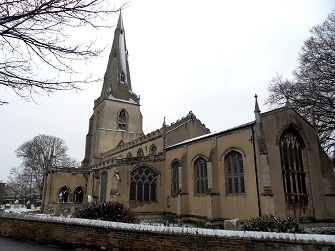
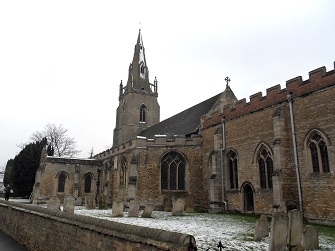 Willingham The first notation of a settlement here was around 1050 when it was known as Vuivlingeham (Wifel's Homestead). The ashlar-faced parish church was is an early 14th century rebuilding of the original place of worship here. Prior to 1924 there were five bells in the tower all cast by Joseph Eayre of St Neots (1755). The five bells were recast and the treble added by Taylors of Loughborough. All six bells are named, starting with the treble they are "Anna", "Mercy", "Peace", "Pity", "Thomas" and "Hairy". The bells are a pleasing six, although the front two require sensitive handling as the stays are thinner than the norm.
The White Horse, Oakington A splendid cosy pub, serving excellent meals and reassuringly warm, an exceptionally important component on days such as this one. Definitely recommended.
Willingham The first notation of a settlement here was around 1050 when it was known as Vuivlingeham (Wifel's Homestead). The ashlar-faced parish church was is an early 14th century rebuilding of the original place of worship here. Prior to 1924 there were five bells in the tower all cast by Joseph Eayre of St Neots (1755). The five bells were recast and the treble added by Taylors of Loughborough. All six bells are named, starting with the treble they are "Anna", "Mercy", "Peace", "Pity", "Thomas" and "Hairy". The bells are a pleasing six, although the front two require sensitive handling as the stays are thinner than the norm.
The White Horse, Oakington A splendid cosy pub, serving excellent meals and reassuringly warm, an exceptionally important component on days such as this one. Definitely recommended.
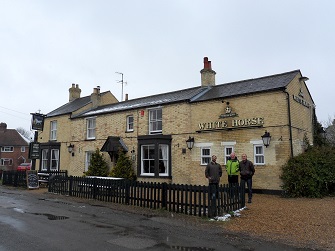
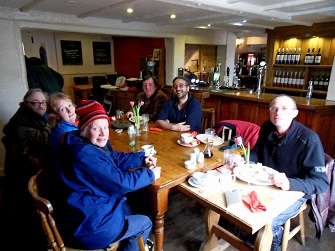 Oakington Documented in the Domesday Book as Hochinton, the name of the village describes an estate associated with a man called Hocca. The primarily 13th century church, although the nave retains 12th century work, is constructed of pebble and stone rubble, comprising a chancel, aisled nave with rebuilt south porch and west tower, which was embattled and buttressed a century later. In the late 20th century the church, supposedly shaken by vibration from low-flying aircraft, had to be closed for worship from time to time. The excellent bells are rung from a well-designed gallery, with the sallies being one of the most unusual colour combinations, purple and black.
Oakington Documented in the Domesday Book as Hochinton, the name of the village describes an estate associated with a man called Hocca. The primarily 13th century church, although the nave retains 12th century work, is constructed of pebble and stone rubble, comprising a chancel, aisled nave with rebuilt south porch and west tower, which was embattled and buttressed a century later. In the late 20th century the church, supposedly shaken by vibration from low-flying aircraft, had to be closed for worship from time to time. The excellent bells are rung from a well-designed gallery, with the sallies being one of the most unusual colour combinations, purple and black.
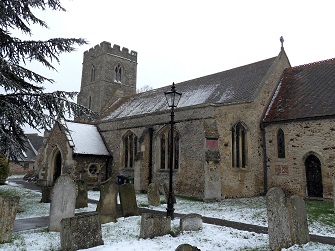
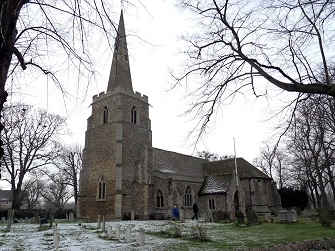 Longstanton The original name Stantonia references the enclosed settlement of stony ground. The village rapidly trebled in size with the opening of RAF Oakington in 1940. The site is now decommissioned and proposed to become England's first eco-town Northstowe. Until as recently as 1953 Longstanton was split into two parishes, the larger Long Stanton All Saints to the north and the smaller Long Stanton St Michael to the south. As a direct result of this the village has two mediaeval churches. St Michael's is no longer used for services, but is maintained by the Churches Conservation Trust as it is a rare example of a church with a thatched roof. All Saints church is a mid-14th century replacement for the original which was destroyed by fire.
Longstanton The original name Stantonia references the enclosed settlement of stony ground. The village rapidly trebled in size with the opening of RAF Oakington in 1940. The site is now decommissioned and proposed to become England's first eco-town Northstowe. Until as recently as 1953 Longstanton was split into two parishes, the larger Long Stanton All Saints to the north and the smaller Long Stanton St Michael to the south. As a direct result of this the village has two mediaeval churches. St Michael's is no longer used for services, but is maintained by the Churches Conservation Trust as it is a rare example of a church with a thatched roof. All Saints church is a mid-14th century replacement for the original which was destroyed by fire.
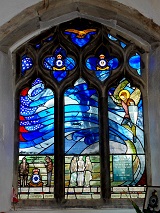
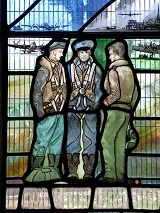
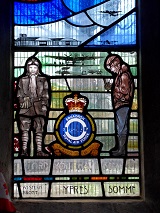
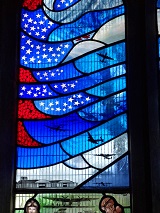 A celebrated stained glass window in the church commemorates The Royal Flying Corps of World War I and the RAF servicemen who served at the local air-force base during World War II. Its panel reads REMEMBER HERE BEFORE GOD THOSE OF 7 SQUADRON WHO DIED IN ACTION IN THE ROYAL FLYING CORPS 1914-18 AND THE ROYAL AIR FORCE 1939-45. The bells are rung from the ground floor, but are well guided and ring beautifully.
A celebrated stained glass window in the church commemorates The Royal Flying Corps of World War I and the RAF servicemen who served at the local air-force base during World War II. Its panel reads REMEMBER HERE BEFORE GOD THOSE OF 7 SQUADRON WHO DIED IN ACTION IN THE ROYAL FLYING CORPS 1914-18 AND THE ROYAL AIR FORCE 1939-45. The bells are rung from the ground floor, but are well guided and ring beautifully.

Over · St Mary

Willingham

The White Horse · Oakington

Lunch

Oakington · St Andrew

Longstanton · All Saints




The stained glass window at Longstanton
Oxfordshire
Saturday 23rd February 2013
14:00 Eynsham
St Leonard (6) 9-1-24 in Ab · Oxon OX29 4HW
16:00 Freeland
St Mary V (6) 3-3-3 in D · Oxon OX29 8AJ
Erica Ashton, Sue Hall, Judy Kirby, Rupert Boulting, Margaret Hewitt, Paul Lucas, Hugh Deam, Anthony Hughes, Guillane Mala, Neil Ephgrave, Roy Jones, Melanie McGregor, Toby Goss, Simon King, Niall Sheekey, Ann Gyngell, Susan King, Colin Taylor and Anthony Williamson.
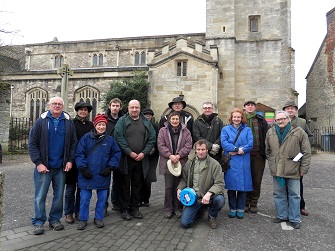
Eynsham · St Leonard
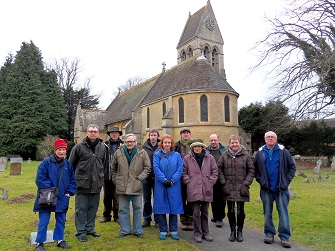
Freeland · St Mary V
Eynsham Documented as Egenes Homme in 864 AD, the name refers to an enclosure belonging to Aegen. The position of the early settlement here was on a gravel terrace above the River Thames at a point that was easy to ford. The Romans almost certainly occupied Eynsham as numerous coins, tiles and pottery of that era have been unearthed locally.
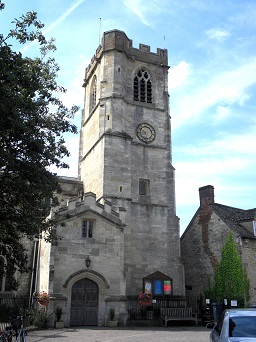 Eynsham Abbey was founded in 1005 by Aethelmar, Earl of Cornwall, and was part of the Benedictine Order. The first abbot was the renowned scholar Aelfric, with the abbey becoming one of the wealthiest in the country. With the Dissolution it was handed over to Henry VIII and the grandiose buildings fell into decay and the stones were later used to construct many of the houses in the village. Fragments preserved in the vicarage garden include a 16th century archway, with a medieval tomb surviving in the churchyard and vestiges of the fish-ponds beside the brook. The River Thames provided Eynsham with a trade route from early times, with a wharf existing here from 1302. It became a vital connection to Oxford and London, sending and receiving coal, corn, salt and stone, with much of the stone used to build the Oxford colleges. The first market trading licence had been granted by King Stephen in 1150. Later Henry II also permitted two fairs per year. The famous toll-bridge of 1769 was constructed primarily due to the hazardous crossing of the river at Swinford which had seen several Welsh sheriffs drowned here, a fate which nearly befell the theologian John Wesley just prior to the bridge being built. The parish church, dedicated to St Leonard, stands on the western side of the market square and dates from the 13th century and was probably the original chapel mentioned in the Abbey records. This was a separate chapel for the people of the village, thus allowing the monks to remain in solitude.
Eynsham Abbey was founded in 1005 by Aethelmar, Earl of Cornwall, and was part of the Benedictine Order. The first abbot was the renowned scholar Aelfric, with the abbey becoming one of the wealthiest in the country. With the Dissolution it was handed over to Henry VIII and the grandiose buildings fell into decay and the stones were later used to construct many of the houses in the village. Fragments preserved in the vicarage garden include a 16th century archway, with a medieval tomb surviving in the churchyard and vestiges of the fish-ponds beside the brook. The River Thames provided Eynsham with a trade route from early times, with a wharf existing here from 1302. It became a vital connection to Oxford and London, sending and receiving coal, corn, salt and stone, with much of the stone used to build the Oxford colleges. The first market trading licence had been granted by King Stephen in 1150. Later Henry II also permitted two fairs per year. The famous toll-bridge of 1769 was constructed primarily due to the hazardous crossing of the river at Swinford which had seen several Welsh sheriffs drowned here, a fate which nearly befell the theologian John Wesley just prior to the bridge being built. The parish church, dedicated to St Leonard, stands on the western side of the market square and dates from the 13th century and was probably the original chapel mentioned in the Abbey records. This was a separate chapel for the people of the village, thus allowing the monks to remain in solitude.
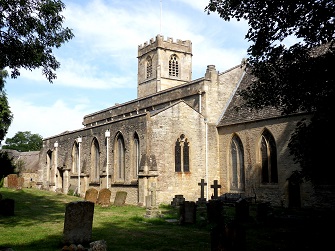 The font just inside the entrance to the church is thought to have been taken from the abbey, and beneath the rim is the face of a "green man" spouting animals from his mouth. There is some fine stained-glass work throughout the church. A will of 1583 evidences that there were some bells here at that time. Some two centuries of absentee vicars saw the bells become so dangerously neglected that ringing was prohibited for safety reasons in the 19th century. The closure of Eynsham paper-mill in 1893 saw 100 local people lose their jobs, but galvanized something of a religious revival and a fund-raising campaign was mounted by the vicar to repair the bells. Only the third bell (1653) and fifth (1673) were able to be retained, with four new bells cast in 1895.
Freeland (This article is from the visit on 16th April 2011) The post-medieval settlement of Frithlands was documented the 16th century, taking its name from the woodland (frith) here that was later renamed Thrift Wood. Late in the 17th century the name of the village was amended to denote that this free land was for the use of locals to graze their livestock.
The font just inside the entrance to the church is thought to have been taken from the abbey, and beneath the rim is the face of a "green man" spouting animals from his mouth. There is some fine stained-glass work throughout the church. A will of 1583 evidences that there were some bells here at that time. Some two centuries of absentee vicars saw the bells become so dangerously neglected that ringing was prohibited for safety reasons in the 19th century. The closure of Eynsham paper-mill in 1893 saw 100 local people lose their jobs, but galvanized something of a religious revival and a fund-raising campaign was mounted by the vicar to repair the bells. Only the third bell (1653) and fifth (1673) were able to be retained, with four new bells cast in 1895.
Freeland (This article is from the visit on 16th April 2011) The post-medieval settlement of Frithlands was documented the 16th century, taking its name from the woodland (frith) here that was later renamed Thrift Wood. Late in the 17th century the name of the village was amended to denote that this free land was for the use of locals to graze their livestock.
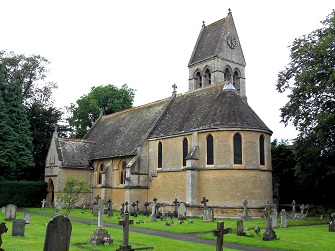 The 18th century mansion of Freeland House was once the home of the Taunton family, who were the primary local landowners, although it now serves as a nursing home. There is also an Anglican convent here in St Mary's House, a Victorian dwelling built to house retired governesses, the convent having been transferred here in 1952 from where it was founded in Wantage. During the second half of the 19th century there were five pubs in the village, but the only one still remaining is the Oxfordshire Yeoman, renamed such in 1974, originally known as the New Inn from 1842. The construction of the church, parsonage and school were all funded by the Taunton family, the High Victorian church being in the Gothic Revival style, and the work of John Loughborough Pearson (1869 - 71), who is considered to have been the finest exponent of recreating the early 13th century style. The tower is unusually attached on the north east side of the church, with a distinctive saddleback roof. The original peal of six bells, with 5cwt tenor were cast at Whitechapel in 1896, with the tenor and 4 being broken up as part of the re-hanging in 2010 that saw two new front bells cast by Whitechapel. This is now the lightest ring of six in Oxfordshire. These bells have a superb sound and they were truly a great pleasure to ring.
The 18th century mansion of Freeland House was once the home of the Taunton family, who were the primary local landowners, although it now serves as a nursing home. There is also an Anglican convent here in St Mary's House, a Victorian dwelling built to house retired governesses, the convent having been transferred here in 1952 from where it was founded in Wantage. During the second half of the 19th century there were five pubs in the village, but the only one still remaining is the Oxfordshire Yeoman, renamed such in 1974, originally known as the New Inn from 1842. The construction of the church, parsonage and school were all funded by the Taunton family, the High Victorian church being in the Gothic Revival style, and the work of John Loughborough Pearson (1869 - 71), who is considered to have been the finest exponent of recreating the early 13th century style. The tower is unusually attached on the north east side of the church, with a distinctive saddleback roof. The original peal of six bells, with 5cwt tenor were cast at Whitechapel in 1896, with the tenor and 4 being broken up as part of the re-hanging in 2010 that saw two new front bells cast by Whitechapel. This is now the lightest ring of six in Oxfordshire. These bells have a superb sound and they were truly a great pleasure to ring.

Eynsham

St Leonard

Freeland · SMV